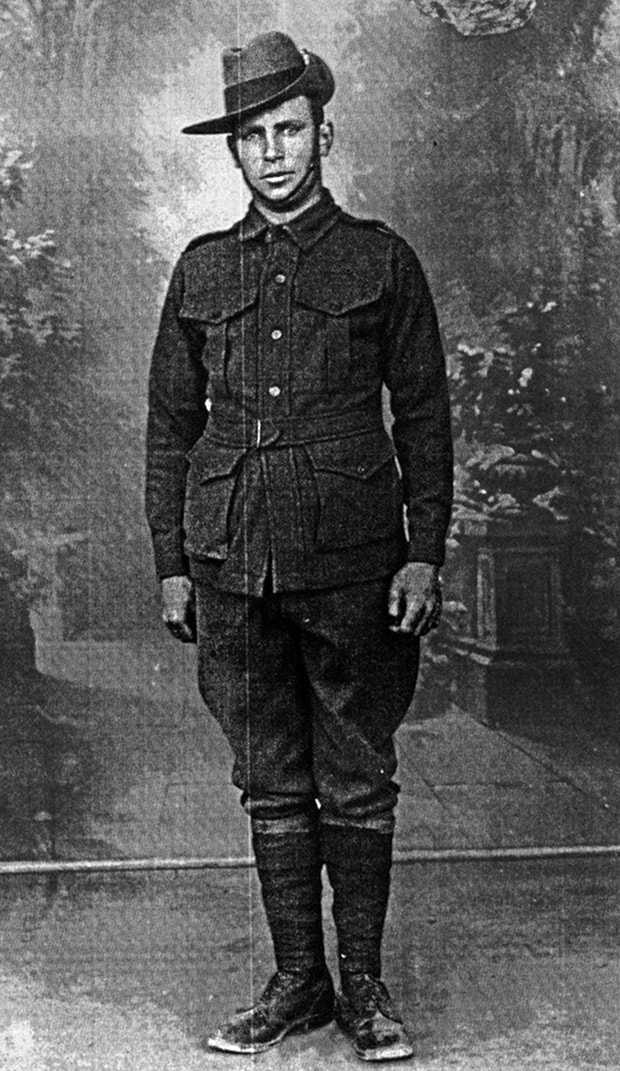Private Fenley John McDonald
7th Battalion
Died Gallipoli, Turkey, April 25, 1915, aged 23 years
10 games for Carlton, 1911-1912
On the afternoon of April 25, when the Carlton and St Kilda players observe a minute’s silence on the Centenary of the Anzac Day landing, solemnly watching on will be local Brunswick resident Chad Nash.
From the terraces of the stadium in Wellington, just moments before the teams do battle in the historic fourth round, Chad will stand in mute tribute to those who gave their young lives in wartime.
Clasping a precious memorial medallion, Chad’s thoughts will inevitably turn to the all-too-short existence of his great uncle - the former Carlton footballer Fenley John McDonald - who was there at Gallipoli on that fateful day.
At dawn on April 25, 1915, Private “Fen” McDonald, together with members of the 7th Battalion of the Australian Imperial Force, was rowed ashore under relentless fire from well-prepared defences.
Somewhere there - perhaps on the water’s edge, or on the sparse, bullet-swept slope behind the beach, Fen paid the ultimate price.
He died a month to the day before turning 24 . . . and his body was never found.
As one of 4200 Australians who fell in this nation’s baptism of fire, Fen has no known grave. But the boy from Nagambie will forever be considered amongst the most revered of Australia’s casualties of war, his name having been etched into the ANZAC memorial at Lone Pine.
Fen McDonald was a 10-game Carlton player through 1911 and ’12, and this club’s first player afforded the No.14 as this was the time when guernsey numbers were first introduced. In the 103 years since, the number has been worn by the likes of Rod McLean, Rod Ashman, Michael Sexton and now Liam Jones, who was Fen’s age at the time of his drafting to this club.

Fenley McDonald played 10 games for Carlton from 1911-1912.
Recently, Chad paid a sentimental visit to the old Carlton ground where his great uncle once vied for infinitely smaller stakes.
Chad came back with the medallion - the “Dead Man’s Penny” as it was so nicknamed - which was presented to the next-of-kin of those who paid the ultimate price in the war to end all wars.
“The reason I brought the penny to the club so it could be present on the anniversary of his death,” Nash said.
“This is a real physical token and it’s a poignant reminder of Fen and his short life. It’s a reminder that Fen was, as a Carlton player, part of a society whose people were asked to lay their lives on the line.
“The Carlton players have a connection with Fen because he was a player. They also have another connection because they, like him, are young.
“And as it happened he died on the day. He died arriving.”
The bronze medallion, measuring 120 millimetres in diameter, features an image of Lady Britannia surrounded by two dolphins (representing Britain’s sea power) and a lion (representing Britain) standing over a fallen eagle (symbolising Germany).
Inscribed around the outer edge of the medallion are the words ‘He died for freedom and honour’. Encased in a frame next to Lady Britannia is the deceased soldier’s name (in this instance Fenley John McDonald) with no rank provided to reflect equality in sacrifice.
The plaque was accompanied by a letter from King George V, which stated: “I join with my grateful people in sending you this memorial of a brave life given for others in the Great War”.
More than a million medallions were produced, marking the sacrifice of men and women who died between August 4, 1914 and April 30, 1920. Most medallions were gratefully received, but many were returned by families to the Australian Government in protest for the profound loss of their loved ones.
For Nash, Fen’s penny serves as a reminder of a short life unfulfilled.
“It also serves as a reminder that war, in the end, is personal,” Nash said.
“If you look at the number, Australia lost an awful lot of people, and of a particular age group also – that’s a generation of young people, something in the order of two per cent of the entire population, and it’s so very sad.”


